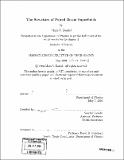The structure of paired boson superfluids
Author(s)
Daniel, Mara S. (Mara Stephanie), 1982-
DownloadFull printable version (1.404Mb)
Other Contributors
Massachusetts Institute of Technology. Dept. of Physics.
Advisor
Senthil Todadri.
Terms of use
Metadata
Show full item recordAbstract
This paper investigates classical and quantum mechanical models of superfluids and superfluid vortices using the Ginsburg Landau energy equation. Specifically, two types of superfluids are considered, ordinary superfluids where single bosons condense to form a strongly correlated system and superfluids where pairs of bosons condense to form a strongly correlated system while the single bosons remain uncondensed. First, the classical minimum energy configuration for an ordinary superfluid with and without a vortex was calculated. Additionally, the phase diagram for the exotic superfluid created by treating single bosons separately from pairs of bosons was determined as was the minimum energy state for each phase. Using these results, I then quantized the Ginsburg-Landau energy and investigated the possibility of excited states by creating small quantum mechanical oscillations about the classical minima. In the uniform superfluid, both the ordinary and exotic superfluids are able to support low energy excitations in the form of sound waves. In addition, the exotic superfluid has a gapped excitation that is a remanant of the uncondensed boson. Finally, the formalism for studying the modes of small oscillation about the classical minimum was developed for the superfluid vortex.
Description
Thesis (S.B.)--Massachusetts Institute of Technology, Dept. of Physics, 2004. Includes bibliographical references (p. 31).
Date issued
2004Department
Massachusetts Institute of Technology. Department of PhysicsPublisher
Massachusetts Institute of Technology
Keywords
Physics.